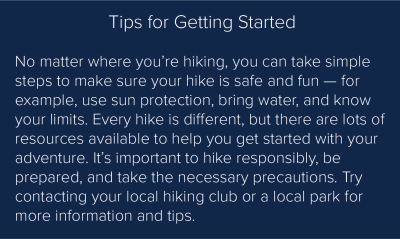By Jennifer Pharr Davis, Member of the President’s Council on Sports, Fitness & Nutrition
No matter who you are or where you live, there’s a hike within reach and a world of benefits to tap into. Many of us think hiking has to take place in the mountains by a beautiful lake or in a gorgeous meadow filled with wildflowers. And many people picture a bearded mountain man in a flannel shirt who’s carrying an enormous pack — with a tin cup and some climbing rope dangling off the back.
You certainly can hike in the mountains, and you can be a bearded “mountain man” sporting a flannel shirt. But that’s a very narrow description of hiking. Really, a hike is just a long walk, and it can happen anywhere — from mountain trails to paths through your own neighborhood.
We’re all hiking a lot more than we think. And we can do it in a lot more places than we think.
There are a host of health reasons — mental, emotional, and physical — to hike. The benefits of nature have gotten a lot of attention of late, and that attention is well-deserved. According to the National Park Service, spending time in nature can make you smarter, stronger, healthier, happier, and more productive. For example, a 30-minute visit to a park can improve cardiovascular health, and frequently spending time in nature can reduce anxiety and depression.
Hiking is also a great way to work toward the recommendations in the Physical Activity Guidelines for Americans (at least 150 minutes of moderate-intensity physical activity and 2 days of muscle-strengthening activity per week). Physical activity reduces the risk of all sorts of health issues — including heart disease, diabetes, high blood pressure, obesity, anxiety, and several types of cancer.
And children benefit from time spent outdoors as much as grown-ups. Spending time in nature not only helps kids meet the recommended 60 minutes a day of physical activity but also can help improve their emotional well-being.
In addition, hiking is one of the most affordable activities you can pursue. You don’t need a gym membership, uniform, or the latest gear to hike. All you really need is a comfortable pair of shoes. Many hiking trails in the United States are accessible with low-cut sneakers. If you’re planning a more moderate to strenuous hike, consider what elements you may encounter — like water, boulders, or slippery ground — and make sure you have the proper footwear to reduce your likelihood of strain or injury.
Where to Hike?
The first places we think of to hike might be parks. In addition to local and state parks, in the United States we’re fortunate to have an incredibly robust national parks system with hundreds of national historic parks, national seashores and lakeshores, and national monuments.
But we also have a wealth of national scenic trails. The Appalachian Trail, for example, passes through 14 states on the East Coast and is within driving distance of major metropolitan areas like Washington, D.C.; New York City; and Boston. In fact, national scenic and national recreation trails crisscross the nation, and that doesn’t even include long-distance “state” trails like the Florida Trail, Mountains-to-Sea Trail in North Carolina, and the Long Trail in Vermont.
You don’t even have to get out of town to hike. Set out with a sense of adventure in your city, and call it an “urban hike”!
There are a variety of outdoor-focused organizations with long histories of getting people outdoors as well as newer organizations that focus on offering opportunities to specific demographic groups. Today, anyone can find a hiking or outdoors group they can relate to! For example, there are groups for people who are Black or African American, people who are Hispanic or Latino, and parents with young kids.
And the Every Kid Outdoors Act has broadened access to the outdoors by letting 4th-graders and their families visit hundreds of parks, lands, and waters for free for an entire year.
When to Hike?
Fall is a great time to take a hike. So are winter, spring, and summer. There’s no bad time of year to get outdoors. Seasons change, weather gets warmer and colder, but the benefits of hiking remain.
Take a Hike!
For me, hiking is not only a great way to get active but also an opportunity to reconnect with nature, allowing it to teach me and make me feel more alive.
The outdoors is imminently accessible, expansive, healing, and free. Famed 19th-century writer and naturalist Henry David Thoreau once said, “We can never have enough of nature” — and his words hold as true now as they did then.





